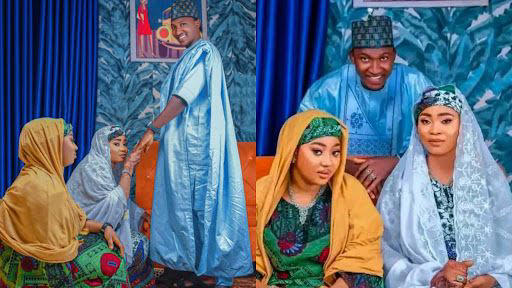A Nigerian man, Usman Abdulmalik, has married two women, Hasiya Ahmad and Maryam Mahmud, on the same day in Bida, Niger State.
In some cultures and religious practices, a man may marry two women simultaneously in a practice known as polygyny, a form of polygamy. Polygyny has historical roots and can be found in various parts of the world, especially in regions where patriarchal traditions are prevalent. For example, in certain African communities, it’s not uncommon for wealthy or influential men to take multiple wives as a symbol of their status and ability to provide for a larger family. This tradition is supported by cultural norms, and in some instances, it’s even written into religious texts or local laws, allowing for such marriages.
In other instances, polygamy might occur due to religious beliefs. Some branches of Islam permit a man to marry up to four women, provided that he treats them equally and fairly. This rule is laid out in the Quran, where it emphasizes fairness and justice between wives. While this practice is still followed in some Muslim-majority countries, it is important to note that many Islamic countries have legal frameworks that limit or regulate polygyny. In certain modern contexts, polygyny is allowed under specific circumstances, though it may require the approval of a religious leader or formal marriage contract.
Another scenario in which a man may marry two women involves a more modern or unconventional lifestyle choice, such as polyamory or open relationships. In these cases, a man may choose to have committed, romantic relationships with multiple partners, though these relationships do not always involve traditional legal marriages. Polyamorous marriages may be based on mutual consent, where all parties involved are aware of and agree to the situation. Some couples may choose to enter into this type of arrangement as a way to navigate their personal desires for multiple romantic or sexual connections while maintaining transparency and respect.
In certain historical contexts, men may have married multiple women due to political or economic reasons. In medieval Europe, for example, kings or nobles often married multiple women to forge alliances with other powerful families. These marriages, while not always based on romantic love, helped to secure political power and economic stability for the ruling families. In some cases, these marriages were arranged for the sake of peace treaties or securing land, with the wives expected to bear heirs to continue the family line. The practice of multiple marriages among royalty was often used to solidify dynastic claims and strengthen a ruler’s influence.
Lastly, in modern-day instances, some men may enter into marriages with multiple women due to personal or emotional needs. This could happen in the context of religious sects or communal living situations where certain beliefs dictate the practice of multiple marriages. For example, in some Mormon fundamentalist communities, men may marry more than one woman, claiming that it is a spiritual duty and part of their religious convictions. These marriages often exist outside the bounds of mainstream law, as such groups may form their own legal systems. In these communities, polygyny is seen as a necessary way to ensure the spiritual well-being of the individuals and maintain their religious traditions.
Have An Advert Or Article You Want Us To Publish? Email: swiftnews0@gmail.com
